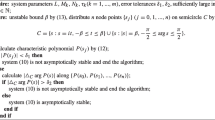Abstract
A new numerical method of integrating the nonlinear evolution equations, namely the Taylor expansion method, was presented. The standard Galerkin method can be viewed as the 0-th order Taylor expansion method; while the nonlinear Galerkin method can be viewed as the 1-st order modified Taylor expansion method. Moreover, the existence of the numerical solution and its convergence rate were proven. Finally, a concrete example, namely, the two-dimensional Navier-Stokes equations with a non slip boundary condition, was provided. The result is that the higher order Taylor expansion method is of the higher convergence rate under some assumptions about the regularity of the solution.
Similar content being viewed by others
References
Temam R.Infinite Dimensional Dynamical Systems in Mechanics and Physics[M]. Springer-Verlag, New York, Berlin, Heidelberg, London, 1988.
Foias C, Sell G R, Temam R. Inertial manifolds for the nonlinear evolutionary equations[J].J Differential Equations, 1988,73(2): 309–353.
Ambrosetti A, Prodi G.A Primer of Nonlinear Analysis[M]. Cambridge University Press, Cambridge, 1995.
Chen Mingjun, Chen Zhongying.Operator Equations and Their Approximate Solutions by Projection Method[M]. Guangdong Science and Technology Press, Guangzhou, 1992 (in Chinese).
He Yinnian, Li Kaitai. Taylor expansion algorithms for the nonlinear operator equations[J].Acta Mathematics Sinica, 1998,41(2): 317–326 (in Chinese).
Li Kaitai, Huang Aixiang, He Yinnian. Full discrete nonlinear Galerkin methods[A]. In: Ying Lungan, Guo Benyu (eds).Numerical Methods for Partal Differential Equations[C]. World Scientific, Singapore, 1992, 61–82.
Marion M, Temam R. Nonlinear Galerkin methods[J].SIAM J Numer Anal, 1989,26(5): 1139–1157.
Devulder C, Marion M, Titi E S. On the rate of convergence of nonlinear Galerkin methods[J].Math Comput, 1993,60(202): 495–514.
Shen Jie. Long time stability and convergence for fully discrete nonlinear Galerkin methods[J].Appl Anal, 1990,38(4): 201–229.
Heywood J G, Rannacher R. On the question of turbulence modeling by the approximate inertial manifolds and the nonlinear Galerkin method[J].SIAM J Numer Anal, 1993,30(6): 1603–1621.
Marion M, Xu Jinchao. Error estimates a new nonlinear Galerkin method based on two-grid finite elements[J].SIAM J Numer Anal, 1995,32(4): 1170–1184.
Temam R.Navier-Stokes Equations, Theory and Numerical Analysis[M]. North-Holland, Amsterdam, 1984.
Garcia-Archilla B, Novo J, Titi E S. An approximate inertial manifolds approach to postprocessing the Galerkin method for the Navier-Stokes equations[J].Math Comput, 1999,68(227): 893–911.
Author information
Authors and Affiliations
Corresponding author
Additional information
Communicated by Zhang Hong-qing and Xu Zheng-fan
Project supported by the National Natural Science Foundation of China (No. 10371095) and the Natural Science Foundation of Shaanxi Province of China (No. 2003 A01)
Rights and permissions
About this article
Cite this article
Yin-nian, H. Taylor expansion method for nonlinear evolution equations. Appl Math Mech 26, 522–529 (2005). https://doi.org/10.1007/BF02465392
Received:
Revised:
Issue Date:
DOI: https://doi.org/10.1007/BF02465392



